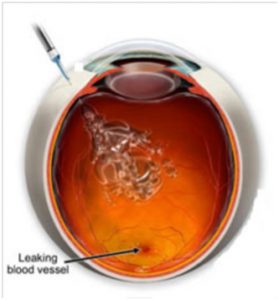An Intravitreal injection is the injection of a medication into the vitreous cavity to treat a particular retinal condition. Patients with wet macular degeneration, retinal vein occlusions or diabetic macular eedema often require treatment with intravitreal injections. Various medications may be injected into the vitreous cavity and these include agents that bind vascular endothelial growth factor (VEGF) or corticosteroids.
Intravitreal injections are usually performed in an outpatient clinic setting under sterile conditions. Local anaesthetic is used during the procedure to numb the eye and topical antiseptic solution is also used to clean the eye prior to the injection. Some discomfort but not severe pain may be experienced at the time of the injection. The injection is given into the eye through the white part of the eye (sclera) approximately 3.5 mm from the junction between the white and the coloured part of the eye (the corneal scleral junction).
After the injection, there maybe locallised redness at the site of the injection from locallised superficial bleeding under the clear skin or conjunctiva that covers the white of the eye. This is known as a subconjunctival haemorrhage. The eye will feel gritty and watery for up to 24 hours before it starts to rapidly improve and feel normal again. You may also experience a few floaters in the first 24 hours after an intravitreal injection. You should not drive when coming to an appointment whereby you are scheduled for an intravitreal injection. There will be drops to be used in the eye that has had an injection for several days after the injection.
One devastating complication of an intraocular injection is an infection inside the eye from bacteria introduced at the time of the injection. Fortunately, the risk of this is low (less than 1 in 3000 injections). However, the symptoms and signs of an infection following an intravitreal injection should not be ignored, because the earlier one receives treatment for an infection, the more likely they will retain vision.
The symptoms of an infection following an intravitreal injection are increasing pain, generallised redness of the white part of the eye, loss of vision, and an increase in floaters. If any of these symptoms are present after an intravitreal injection, you should contact your treating Ophthalmologist immediately.

